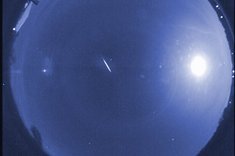When skywatchers think of meteor showers during the month of December, they immediately think of the Geminids, which has evolved over the years into the most prolific and reliable of the dozen or so annual meteor displays. But there is another notable meteor shower in December that, in contrast, hardly gets any notice: the December Ursids.
The peak of this meteor display usually occurs during the overnight hours of Dec. 21-22.
The Ursids gain their name from the constellation of Ursa Minor, the Little Bear. They appear to fan out from the location of the bright orange star Kochab, also located Ursa Minor. Kochab is the brighter of the two outer stars in the bowl of the Little Dipper (the other being Pherkad) that seem to march in a circle like sentries around Polaris, the North Star. Some call these meteors the Umids, in a rather unsuccessful attempt to make clear that their radiant is in Ursa Minor, not Ursa Major. [Ursid Meteor Shower 2017: When, Where & How to See It ]
The 2017 Ursid meteor shower peaks during the overnight hours of Dec. 21-22 and radiates out from the constellation Ursa Minor, as shown in this NASA sky map. But dark skies are needed to see the display’s 10 meteors per hour.
Credit: NASA/JPL-Caltech
Often neglected
Because Kochab is so close to the North Pole of the sky, this star almost never sets for most viewers in the Northern Hemisphere. And since the Ursids seem to fan out from this region of the sky (making it the radiant for the Umid shower), you can look for these faint, medium-speed meteors all through the night. This year, you should have a good shot at spotting some: The moon is new on Dec. 18, assuring dark skies.
These meteors are best seen during the last dark hour before dawn, when the radiant lies highest above the horizon in a dark sky. On the morning of maximum, from five to 10 Ursids may be seen per hour. Plunging through the Earth’s atmosphere at 22 miles (35 kilometers) per second, the Ursids consist of mostly medium-speed meteors. Very little activity will be seen outside the night of maximum activity.
This is indeed fortunate, because the Ursids “badly need observing,” said the British Astronomical Association.
Indeed, the Ursids are a very poorly observed Northern Hemisphere shower, which has nonetheless produced at least two major outbursts in the past 70 years, in 1945 and 1986. Some other outbursts could have been missed due to weather conditions. Several lesser rate-enhancements were also reported from 2006 to 2008; those might have been influenced by the relative proximity of the shower’s parent comet, 8P/Tuttle, which circles the sun in a 13.6-year orbit and most recently swept past the sun in January 2008.
And for some still-unexplained reason, many Ursid peaks have occurred when Comet Tuttle was not sweeping through the inner solar system, but rather at the far end of its orbit (aphelion), as far away from the sun as the comet can get. Slightly enhanced rates were found in video data in 2014 and 2015, as well, indicating the difficulty of trying to forecast what this meteor swarm might do in a given year. [Best Night Sky Events of December 2017 (Stargazing Maps) ]

0 of 10 questions complete
Enhanced activity?
No unusually strong activity has been forecasted for the 2017 shower. Computer simulations by the French astronomer Jérémie Vaubaillon do suggest that on Friday (Dec. 22) at 9:43 p.m. EDT (1443 GMT), Earth will approach a dust trail ejected by comet Tuttle back in 884. But unfortunately, most of North America will be in daylight when Earth is closest to this dusty trail of comet debris.
Still, if you’re up before dawn breaks that morning, and if your skies are clear, you might want to step outside and check the northern sky. December’s new moon gives a perfect chance to end the year on a positive note, if skies are clear enough to see what the Ursids do this time.
Editor’s note: If you snap an amazing Ursid meteor shower photo that you’d like to share with us and our news partners for a possible story or image gallery, send images and comments to us at: spacephotos@space.com.
Joe Rao serves as an instructor and guest lecturer at New York’s Hayden Planetarium. He writes about astronomy for Natural History magazine, the Farmer’s Almanac and other publications, and he is also an on-camera meteorologist for Verizon Fios1 News, based in Rye Brook, New York.Follow us @Spacedotcom , Facebook and Google+ . Original article on Space.com .

Comments are closed.